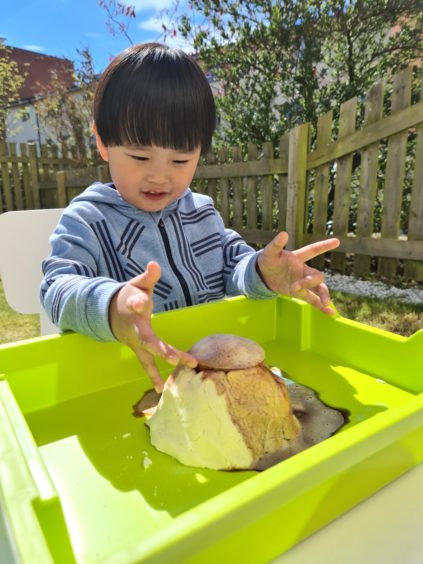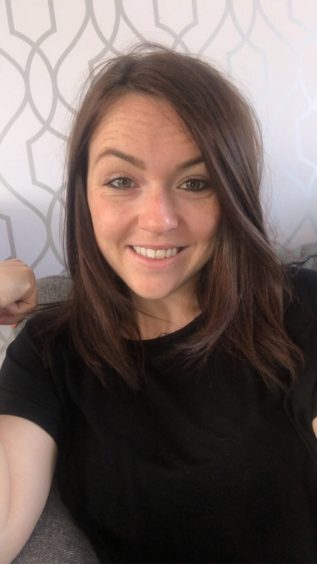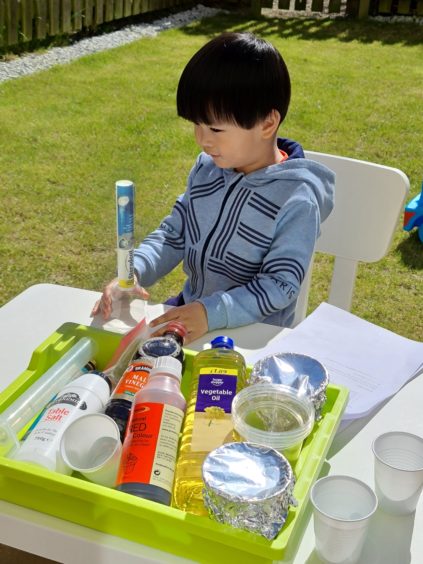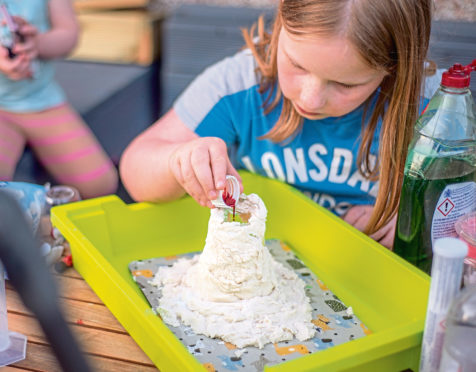Parents, it is safe to argue,have never had greater respect for teachers.
Having home schooled their children for nearly two months most have come to realise what a demanding and skilled job it is.
It doesn’t help that museums, art galleries and other places you might take your kids to for a bit of educational entertainment during the holidays have also been forced to shut their doors.
One of the most popular places for sneaking some education into children’s heads is Dundee Science Centre, which has been making physics, chemistry and biology enjoyable for years.
Closed it may be but it will take more than that to prevent its boffins from helping youngsters get the most out of science.
They’ve come up with a range of exciting experiments children can carry out at home – with the appropriate adult supervision of course.
Salt dough volcanoes mix salt, flour and water to make a volcano, then baking soda, washing up liquid, food colouring and vinegar to create a colourful eruption of lava.

Carlene Cura is development and fundraising adviser at Dundee Science Centre. She says there’s no better time to learn about science than when you’re a child. “Science is all around us, not just in schools and labs,” she explains. “Right now more than ever, it’s important to make science learning relevant and fun for children and adults, and to encourage children to engage with science. We’re all scientists in some way and, if we can manage to engage young learners in a science experience that leaves a legacy with them, then we’ve achieved our aim.”

“Yes, we’re a visitor attraction which unfortunately had to close temporarily, but our engagement with the community extends far beyond our physical presence and our home learning programme has shown that we can still deliver. Sometimes it’s as simple as encouraging families to explore activities within their homes or gardens – that way, everyone is learning, questioning the world around us, and having fun.”
Another experiment Carlene and her team have put together is Racing Rockets. The ingredients are simple – a tube of Steradent denture cleaning tablets, water, and a tray or flat piece of wood to use as a launchpad. To create the rocket, empty out the tablets from the tube, fill the empty tube to around one third with water, break up three or four tablet and put them into the tube with the water.
Put the lid on the tube and give it a thorough shake for around five seconds then put the rocket on the launchpad and wait for liftoff!
If you have a second tube you can make more than one rocket and race them to see which goes the farthest.

Carlene and her colleagues may be working from home like many other people but that doesn’t mean they aren’t just as passionate about helping create the next generation of scientific minds.
She’s also very aware that many working parents need all the help they can get home schooling their children.
“We’ve developed a Home Learning Programme packed with weekly, themed activities for children to work through independently, or with their family’s input. Home learning was a daunting prospect for many so it’s fantastic to hear so many families report back on how the programme is helping keep their children busy, engaged and entertained during lockdown. There are so many ways a child will learn but enjoyment is key so our activities have been designed with that in mind, providing lots of fun and fascination whether you’re at the kitchen table, in the garden or taking your daily walk.”
Another experiment the science centre has put together is to design a lava lamp. Simply choose a container – anything see-through will do, from a glass to a plastic bottle or even a test tube if you want your lamp to look especially scientific.
You’ll also need oil, water and some more Steradent tablets, as well as food colouring if you want a particular colour of lamp.
Fill the container one third full of water and top the rest up with oil. The oil should float on top of the water. Add a few drops of food colouring then break up two Steradent tablets and drop them in. Then enjoy your lava lamp – lots of bubbles should come up through the oil. Once it stops fizzing you can add more tablets to keep it going.
Carlene hopes everyone will give at least one of the experiments a try. “These experiments form what we call ‘DIY Science’, meaning anyone can do them with things you’ll find around the home. You don’t have to be a scientist to deliver a really exciting science experiment.”
For all of Dundee Science Centre’s DIY Science projects visit dundeesciencecentre.org.uk
